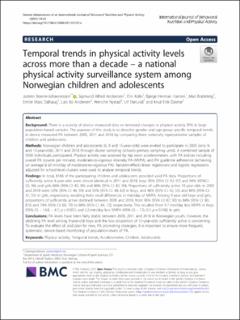| dc.contributor.author | Steene-Johannessen, Jostein | |
| dc.contributor.author | Anderssen, Sigmund Alfred | |
| dc.contributor.author | Kolle, Elin | |
| dc.contributor.author | Hansen, Bjørge Hermann | |
| dc.contributor.author | Bratteteig, Mari | |
| dc.contributor.author | Dalhaug, Emilie Frederikke Mass | |
| dc.contributor.author | Andersen, Lars Bo | |
| dc.contributor.author | Nystad, Wenche | |
| dc.contributor.author | Ekelund, Ulf | |
| dc.contributor.author | Dalene, Knut Eirik | |
| dc.coverage.spatial | Norway | en_US |
| dc.date.accessioned | 2021-08-16T10:47:59Z | |
| dc.date.available | 2021-08-16T10:47:59Z | |
| dc.date.created | 2021-06-17T11:53:06Z | |
| dc.date.issued | 2021 | |
| dc.identifier.citation | Steene-Johannessen, J., Anderssen, S. A., Kolle, E., Hansen, B. H., Bratteteig, M., Dalhaug, E. M., … Dalene, K. E. (2021). Temporal trends in physical activity levels across more than a decade – a national physical activity surveillance system among Norwegian children and adolescents. International Journal of Behavioral Nutrition and Physical Activity, 18(1), 55. | en_US |
| dc.identifier.issn | 1479-5868 | |
| dc.identifier.uri | https://hdl.handle.net/11250/2767965 | |
| dc.description.abstract | Background
There is a scarcity of device measured data on temporal changes in physical activity (PA) in large population-based samples. The purpose of this study is to describe gender and age-group specific temporal trends in device measured PA between 2005, 2011 and 2018 by comparing three nationally representative samples of children and adolescents.
Methods
Norwegian children and adolescents (6, 9 and 15-year-olds) were invited to participate in 2005 (only 9- and 15-year-olds), 2011 and 2018 through cluster sampling (schools primary sampling units). A combined sample of 9500 individuals participated. Physical activity was assessed by hip worn accelerometers, with PA indices including overall PA (counts per minute), moderate-to-vigorous intensity PA (MVPA), and PA guideline adherence (achieving on average ≥ 60 min/day of moderate-to-vigorous PA). Random-effects linear regressions and logistic regressions adjusted for school-level clusters were used to analyse temporal trends.
Findings
In total, 8186 of the participating children and adolescents provided valid PA data. Proportions of sufficiently active 6-year-olds were almost identical in 2011 and 2018; boys 95% (95% CI: 92, 97) and 94% (95%CI: 92, 96) and girls 86% (95% CI: 83, 90) and 86% (95% CI: 82, 90). Proportions of sufficiently active 15-year-olds in 2005 and 2018 were 52% (95% CI: 46, 59) and 55% (95% CI: 48, 62) in boys, and 48% (95% CI: 42, 55) and 44% (95% CI: 37, 51) in girls, respectively, resulting from small differences in min/day of MVPA. Among 9-year-old boys and girls, proportions of sufficiently active declined between 2005 and 2018, from 90% (95% CI: 87, 93) to 84% (95% CI: 80, 87)) and 74% (95% CI: 69, 79) to 68% (95% CI: 64, 72), respectively. This resulted from 9.7 min/day less MVPA in boys (95% CI: − 14.8, − 4.7; p < 0.001) and 3.2 min/day less MVPA (95% CI: − 7.0, 0.7; p = 0.106) in girls.
Conclusions
PA levels have been fairly stable between 2005, 2011 and 2018 in Norwegian youth. However, the declining PA level among 9-year-old boys and the low proportion of 15-year-olds sufficiently active is concerning. To evaluate the effect of, and plan for new, PA promoting strategies, it is important to ensure more frequent, systematic, device-based monitoring of population-levels of PA. | en_US |
| dc.language.iso | eng | en_US |
| dc.publisher | BioMed Central | en_US |
| dc.rights | Navngivelse 4.0 Internasjonal | * |
| dc.rights.uri | http://creativecommons.org/licenses/by/4.0/deed.no | * |
| dc.subject | physical activity | en_US |
| dc.subject | temporal trends | en_US |
| dc.subject | accelerometer | en_US |
| dc.subject | children | en_US |
| dc.subject | adolescents | en_US |
| dc.title | Temporal trends in physical activity levels across more than a decade – a national physical activity surveillance system among Norwegian children and adolescents | en_US |
| dc.type | Peer reviewed | en_US |
| dc.type | Journal article | en_US |
| dc.description.version | publishedVersion | en_US |
| dc.rights.holder | © The Author(s) 2021 | en_US |
| dc.source.pagenumber | 11 | en_US |
| dc.source.volume | 18 | en_US |
| dc.source.journal | International Journal of Behavioral Nutrition and Physical Activity | en_US |
| dc.identifier.doi | 10.1186/s12966-021-01120-z | |
| dc.identifier.cristin | 1916382 | |
| dc.relation.project | Norges forskningsråd: 249932 | en_US |
| cristin.ispublished | true | |
| cristin.fulltext | original | |
| cristin.qualitycode | 2 | |

